Boost User Retention: Effective Mobile App Engagement Strategies in 2023
In today's ultra-competitive app market, mobile app engagement has become a critical factor for success. With millions of apps available across various platforms, app developers face the challenge of standing out and retaining users.
According to Statista, the number of apps available on popular app stores such a Google Play and the App Store is 3,553,550 and 1,642,759. The data on the uninstall rate of these apps speaks for itself. In some regions, the global app uninstall rate after 30 days is over 50 percent.
Successful companies like Packed have turned to mobile app marketing agencies like Kurve to design their app marketing strategies to address these challenges.
This guide will unveil the secrets of effective mobile app engagement strategies in 2023. From user onboarding to personalized notifications and gamification, we will explore proven techniques to boost user retention and maximize your app's potential.
What is Mobile App Engagement?
Mobile app engagement refers to users' interaction, involvement, and activity with a mobile app. It goes beyond downloads and installations. It focuses on how users interact with the app's features, functionalities, and content. It measures how users actively use and derive value from the app.
Imagine a fitness-tracking app that allows users to set goals, track their workouts, and track their progress. Mobile app engagement in this context would be users logging their activities, updating their plans, exploring new features, and sharing their achievements with the app's community. It reflects the users' ongoing interest, participation, and satisfaction with the app.
Active engagement can manifest in various forms:
- Frequent app usage
- High session durations
- Repeated visits
- Interactions with in-app content
- Participation in app-specific activities
It is a crucial metric for app developers and marketers. Active engagement indicates the success of their efforts in delivering a compelling user experience and retaining loyal users.
What is App User Retention?
App user retention refers to the ability of a mobile app to keep users engaged over a specific period. It measures the percentage of users who continue to use an app after an initial download or installation.

User retention plays a crucial role in mobile app engagement. While app engagement focuses on the level of interaction and activity within the app, user retention looks at the longevity of that engagement. It signifies the app's ability to keep users returning for more.
High user retention indicates that users find value in the app and are likely to continue using it. It shows the app's success in building a loyal user base. App developers and marketers strive to enhance user retention by implementing engagement strategies like personalized experiences, regular updates, rewards programs, and proactive customer support.
App companies can create a sustainable and thriving app ecosystem that fosters long-term user relationships and drives business growth by understanding and optimizing mobile app engagement and user retention.
Why is there a Need for a Mobile App Engagement Strategy?
A mobile app engagement strategy is essential for several reasons.
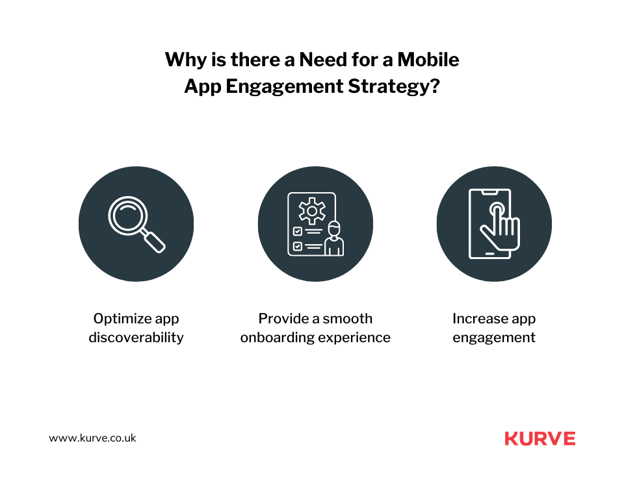
- It helps app companies combat the high competition in the app market. With millions of apps available, standing out and creating a memorable user experience is crucial for success.
- It enhances user satisfaction and loyalty. App companies can foster a strong connection and build a loyal user base by actively engaging users and meeting their needs. Satisfied users are more likely to recommend the app to others, leading to organic growth.
- It increases user retention. App companies can keep users returning and using the app by providing value, personalized experiences, and relevant content.
- It drives business growth. Engaged users are more likely to make in-app purchases, subscribe to premium features and become brand advocates. This can lead to higher revenue generation and increased customer lifetime value.
Important Metrics in Measuring Mobile App Engagement
There are many key metrics that help measure and evaluate the effectiveness of your app's engagement strategies.
These metrics provide valuable insights into user behavior, usage patterns, and overall app performance. Tracking and analyzing these metrics allows you to make data-driven decisions and optimize your app to enhance user engagement and retention.
From app sessions and retention rates to active users and daily uninstalls, we will cover a range of metrics that provide a comprehensive picture of your app's engagement levels.
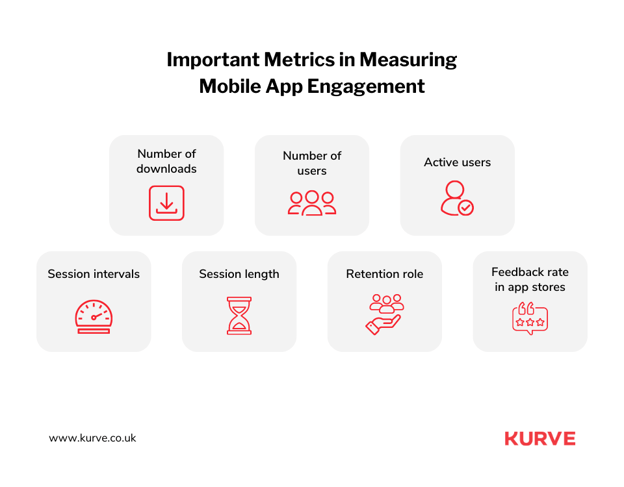
App Session
App session refers to a single instance of user interaction with your app. It provides insights into how users engage with different features and functions during a session. Tracking app sessions reveals the duration and frequency of user interactions. This helps you identify patterns and optimize the user experience.
By monitoring app sessions, you can uncover trends - like peak usage times or session length - and make informed decisions to enhance user engagement. For example, if you notice users tend to have shorter app sessions, you can explore ways to make the initial onboarding process more intuitive and captivating.
Analyzing app sessions empowers you to improve user engagement and retention. By examining session duration, frequency, and the actions users take within each session, you can tailor your app's content, features, and interface to align with user preferences and expectations. Doing so ensures a seamless and enjoyable experience.
App Stickiness
App stickiness measures the ability of your app to keep users and foster long-term engagement. It reflects whether your app becomes integral to users' daily lives. Are they compelled to return frequently and interact with your app's content and features?
Offering unique value propositions, personalization, and gamified elements, creates a habit-forming experience. In addition, nurturing a sense of community within your app can enhance stickiness by fostering connections and encouraging user-generated content.
Monitoring app stickiness provides insights into the effectiveness of your engagement strategies and user satisfaction levels. By analyzing metrics like user retention, session frequency and time spent per session, you can identify areas for improvement. You can also implement targeted initiatives to enhance app stickiness and cultivate a loyal user base.
Retention Rate
Retention rate is a critical metric that measures the percentage of users who continue to use your app over a given period. It serves as a critical indicator of user satisfaction and long-term loyalty.
Improving the retention rate is essential for sustainable growth and maximizing the value of your user base. You can increase user satisfaction and encourage long-term app usage by delivering a seamless onboarding experience, providing value through new features and content, and fostering meaningful interactions.
You can also segment users based on behavior, preferences, or demographics. That way, you can personalize experiences and tailor retention efforts to specific user segments, driving higher retention rates and fostering a loyal user community.
Active Users
Active users are the lifeblood of your app. They represent the vibrant community of individuals who engage with your app's features and content. They are the driving force behind app success and are crucial in achieving your business goals.
Understanding the behavior and preferences of active users allows you to tailor your app experience to their needs. It allows you to provide personalized content, relevant recommendations, and seamless interactions. As a result, you cultivate loyalty, drive user retention, and amplify engagement by fostering a strong connection with your active user base.
Tracking active users uncovers valuable insights, including engagement patterns, popular features and user satisfaction levels. With this information, you can make data-driven decisions, optimize app performance, and refine engagement strategies to keep users involved and excited about your app.
Daily Uninstalls
Daily uninstalls shed light on the number of users who bid farewell to your app each day. Monitoring this metric is crucial. It reveals potential pain points, usability issues, or gaps in the user experience that may prompt users to part ways with your app.
You gain valuable insights into user sentiment by analyzing the number of daily uninstalls. It also highlights areas for improvement. This enables you to enhance the app's usability, address user concerns, and deliver a more compelling experience that reduces uninstall rates and boosts user retention.
Keeping daily uninstalls to a minimum is paramount for sustaining a thriving user base. You can achieve this by refining your app based on user feedback, addressing bugs or glitches, and offering timely updates and new features.
Screen Views
Screen views give you a window into user interactions within your app, revealing which screens or pages captivate users the most. Understanding different screens' popularity and engagement levels empowers you to optimize user flows, content placement, and design elements to create an intuitive and immersive app experience.
By analyzing screen views, you can identify hotspots of user activity. Utilizing these hotspots by placing engaging content, CTA buttons, or personalized recommendations helps drive deeper engagement, increase session durations, and guide users toward practical actions within your app.
Unlocking the full potential of screen views involves a holistic approach to app design and content strategy. By employing eye-catching visuals, intuitive navigation, and relevant content that aligns with user expectations, you can create a seamless and enjoyable app journey that keeps users exploring and interacting with multiple screens.
Time Spent on App
The time users spend within your app during each session is a critical metric. It gauges their level of interest, involvement, and satisfaction.
Increasing time spent on apps requires creating captivating content, valuable functionalities, and personalized experiences that keep users hooked. You can captivate users' attention and encourage extended sessions by offering exclusive features, compelling multimedia content, or interactive elements.
Time spent on the app is an indicator of user affinity and loyalty. By refining your app's content, enhancing usability, and addressing pain points, you can create an immersive and addictive app experience. This keeps users engaged, fosters brand loyalty, and positions your app for long-term success.
Effective Mobile App Engagement Strategies
As we dive deeper into mobile app engagement, we must explore practical strategies to elevate your app's visibility and drive remarkable growth. At Kurve, we specialize in mobile app marketing, offering cutting-edge strategies to boost your app's success. Our services, known as APPXL, combine organic and paid methods to create efficient and consistent growth.
Through various assets, including extensive keyword research and influencer partnerships, we ensure scalable growth along your app's journey. With a focus on data-driven approaches and a customized marketing strategy based on your specific needs, we help you achieve app excellence.
In the following sections, we will unveil a range of powerful strategies and techniques to enhance your mobile app engagement. From optimizing app store presence to leveraging social media and influencer marketing, we have the expertise to make your app stand out in the competitive market.
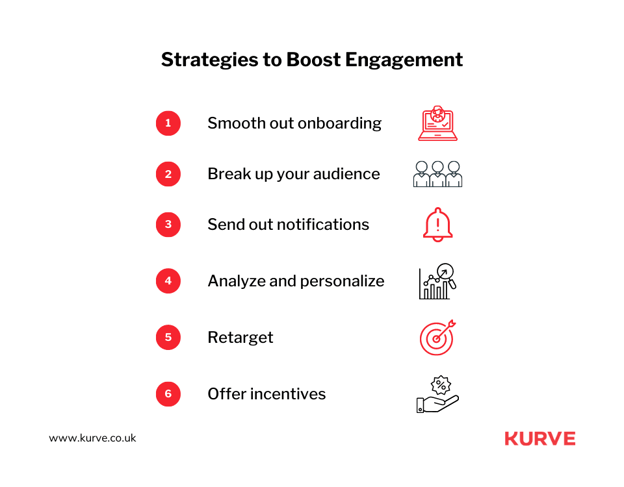
Tell the App Story and Mission
Captivate your users by crafting a compelling and authentic app store when they discover your app. Share your app's mission and values, creating an emotional connection that resonates with your target audience. You can leave a lasting impression by vividly showing the problems your app solves and its unique benefits.
To bring your app story to life, leverage storytelling techniques that engage and captivate your users. Use relatable examples, anecdotes, or even user testimonials to highlight the impact your app can have on their lives. By connecting with users on a deeper level, you can inspire their curiosity and drive engagement.
When crafting your app store, avoid overpromising or exaggerating claims. Instead, be transparent and highlight the genuine value your app delivers. You can build trust and foster long-term user engagement by staying true to your mission and values.
Make the Onboarding Process Sleeker
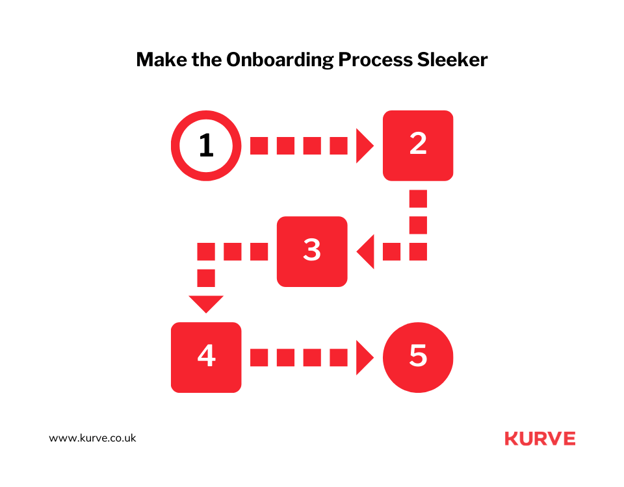
The goal is to provide users with a smooth introduction to your app's core features, making it easy to explore and navigate.
To achieve a sleek onboarding process, keep it concise and user-friendly. Use interactive tutorials, appealing animations, or guided tours to introduce users to key functionalities. Use clear and intuitive design elements that guide users through the onboarding journey.
Consider incorporating personalized elements into the onboarding process. You can tailor the experience based on user preferences or previous interactions to make users feel valued and understood. You can ignite their interest and encourage further exploration by delivering relevant content and recommendations.
Avoid overwhelming users with excessive information. Keep the focus on essential features and gradually introduce more advanced functionalities as users become familiar with your app. Remember, simplicity and clarity are vital to ensuring a seamless onboarding experience.
Consider Personalization
Unlock the power of personalization to create a unique and tailored app experience for your users. By understanding their preferences, behaviors, and needs, you can deliver personalized content, recommendations, and interactions that resonate.
To harness the potential of personalization:
- Leverage user data intelligently.
- Analyze their past interactions, preferences, and demographic information. This uncovers insights that drive personalization efforts.
- Use this data to customize the app experience. You can offer relevant content, personalized offers and individualized user interfaces.
Harness the capabilities of machine learning and predictive analytics to automate and optimize personalization at scale. These technologies enable real-time analysis and dynamic adaptation, ensuring users receive timely and highly relevant experiences.
While implementing personalization, prioritize user privacy and data security. Get explicit consent for data collection and use, and ensure compliance with relevant regulations. Regularly review and refine your personalization efforts to align with user expectations and continuously enhance the value you provide.
With a personalized app experience, you can foster more robust connections, boost user engagement, and drive higher retention rates. Tailoring your app to each user's unique preferences and needs creates a sense of exclusivity and enhances their overall satisfaction.
Gamify the App Experience
Infuse excitement and engagement into your app by incorporating gamification elements. Gamify the app experience by integrating challenges, achievements, leaderboards, or virtual rewards. These incentivize users to participate and progress within the app actively.
Identify critical actions or milestones within your app that align with user goals or desired behaviors to gamify. Design game mechanics that reward users for completing these actions, such as unlocking levels, earning points, or receiving virtual badges. This adds an element of fun, provides a sense of accomplishment, and encourages users to continue using your app.
Consider creating social interactions and competitions within the app. Enable users to connect with friends, compare achievements, and engage in friendly competition. This fosters community and healthy rivalry, further enhancing the gamified experience.
Gamification elements should complement your app's core purpose, not overshadow its main functionalities. Strive for a balance between game elements and the app's primary value proposition, ensuring it enhances user engagement and reinforces the app's objectives.
Apply Push Notifications Appropriately
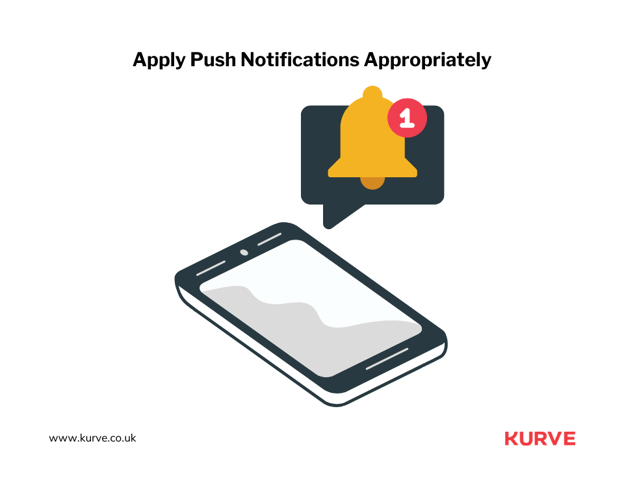
Push notifications can deliver timely, relevant, and engaging messages to your app users. Craft compelling notifications that capture users' attention and provide value. Use personalized messages, exclusive offers, or time-sensitive updates to drive user engagement.
To make push notifications effective, segment your user base. Then, you can tailor the content based on their preferences, behaviors, or location. By delivering targeted notifications, you increase the chances of users finding the messages relevant and taking action.
Strike the right balance between frequency and relevance. Avoid bombarding users with excessive notifications, leading to annoyance and app uninstalls. Instead, focus on delivering valuable messages. For example, reminding users about unfinished tasks, sharing personalized recommendations, or updating them about relevant app updates.
Respect user preferences and provide granular control over notification settings. Allow users to choose the types of notifications they wish to receive and their delivery frequency. This empowers users to personalize their app experience and ensures that notifications align with their preferences.
Offer Loyalty Programs
Build long-term relationships with your app users by implementing loyalty programs that reward and incentivize their ongoing engagement. A loyalty program gives users a sense of exclusivity and benefits for their loyalty and continued use of your app.
Design a loyalty program that aligns with your app's objectives and user preferences. Consider rewarding users for completing specific actions, like making purchases, referring friends, or achieving certain milestones within the app. Offer enticing rewards, like exclusive discounts, premium features, or VIP access, or implement a point-based system or tiered structure that allows users to accumulate points or progress through different levels based on their engagement and loyalty.
Regularly communicate and engage with loyalty program participants. Keep them informed about new rewards, upcoming promotions, or personalized offers to maintain their excitement and motivation to stay engaged with your app.
The rewards and benefits provided through the program not only incentivize users to continue using your app but also create a positive and rewarding experience that keeps them coming back for more.
Make a Referral System

Tap into the power of word-of-mouth marketing by implementing a referral system in your app. Encourage existing users to refer your app to their friends and contacts, rewarding both the referrer and the new user.
Create a seamless and user-friendly referral process within your app. Provide users with unique referral links or codes to share with others. Offer incentives, such as discounts, exclusive content, or bonus features, to motivate users to refer others to your app.
To maximize the effectiveness of your referral system:
- Optimize the messaging and promotion around it.
- Communicate the benefits of referring the app, highlighting the value the referrer and the new user will receive.
- Leverage in-app prompts, push notifications, or email campaigns to remind and incentivize users to make referrals.
Regularly track and measure the success of your referral program. Monitor the number of successful referrals, the acquisition of new users, and the impact on user engagement. Use this data to refine and improve your referral system over time.
Develop Social Features in the App
Incorporating social features foster a sense of community and social interaction within your app. Enabling users to connect, interact, and share their experiences with others creates a vibrant and engaging app environment.
Integrate social login options, allowing users to sign up or log in using their social media accounts. This simplifies registration and encourages users to engage with your app more easily.
Implement social sharing capabilities that enable users to share their achievements, progress, or personalized content from your app on social media platforms. Social sharing helps generate organic exposure and attract new users through user-generated content.Encourage user-generated content and user interactions within your app. Features like comments, likes, or reviews enable users to engage with each other's content and provide feedback.
Monitor and moderate user interactions to ensure a positive and safe social environment within your app. Be sure to address users' issues or concerns to maintain a positive user experience.
Leverage Email and Social Media
Build an email list of app users and implement targeted email campaigns. Send personalized messages, relevant updates, and exclusive offers to keep users informed and engaged. Use email automation tools to schedule and send automated emails based on user behavior or app-specific events.
Leverage social media platforms to engage with your app users and attract new ones. Create engaging content, share app updates, and interact with your audience through posts, stories, and live sessions. Be sure to encourage users to follow your social media accounts for the latest news, updates, and exclusive promotions related to your app.
A great strategy is to integrate social media sharing options within your app. When users can share their app-related experiences or achievements on their social media profiles, it generates organic exposure. It can also attract new users through user-generated content and recommendations.
Regularly analyze and optimize your email and social media marketing efforts. Monitor key metrics, such as email open rates, click-through rates, social media engagement, and follower growth. Use the insights gained to refine your strategies and deliver content that resonates with your app users.
Optimize the User Experience Consistently
Deliver a seamless and enjoyable user experience by prioritizing ongoing optimization. You can achieve this by deploying several tactics:
- Monitor user feedback, conduct usability tests, and analyze app usage data to identify areas for improvement.
- Update your app's design, features, and functionality based on user insights and emerging trends. Streamline navigation, enhance performance, and eliminate friction points hindering user engagement.
- Use A/B testing to experiment with different variations of app elements and determine the most effective design and user flow. Test changes in small increments and measure the impact on user engagement and satisfaction.
- Gather qualitative and quantitative feedback through in-app surveys, user interviews, and ratings and reviews. Use this feedback to gain valuable insights into user preferences and pain points, allowing you to make informed decisions for enhancing the user experience.
- Stay current with industry standards, best practices, and technological advancements. Benchmark your app against competitors and seek inspiration from leading apps in your niche.
By optimizing the user experience, you can create a compelling and delightful app that keeps users engaged and encourages long-term app usage.
Try Using Chatbots

Enhance user engagement and provide instant support by incorporating chatbots into your app. Chatbots can offer personalized assistance, answer frequently asked questions, and respond promptly to user inquiries.
Develop a chatbot with a conversational and natural language interface. It's important that it aligns with your app's tone and brand personality. Ensure the chatbot is accessible and provides a seamless user experience.
Leverage artificial intelligence and machine learning to train the chatbot to understand user queries and provide relevant and accurate responses. Enable the chatbot to handle a wide range of user interactions. Some examples include providing information, guiding users through processes, suggesting personalized recommendations, and resolving common issues. Finally, integrate the chatbot with your app's knowledge base and backend systems for efficient and practical assistance.
Regularly evaluate the chatbot's performance and user satisfaction through user feedback and analytics. Identify areas for improvement and refine the chatbot's responses and capabilities to ensure a seamless and valuable user experience.
Retarget Audience When Things Fail
Sometimes, things go wrong. When users face challenges or encounter errors within your app, they may call it a day. Therefore, it's crucial to implement effective retargeting strategies to re-engage and retain them.
Implement an error tracking system to identify common issues and errors experienced by users. Use this data to address these issues and provide solutions to users to minimize frustration and improve their experience.
Develop a retargeting strategy that includes personalized messaging and offers to encourage users to return to your app after encountering difficulties. For example, send targeted push notifications, emails, or in-app messages highlighting solutions, offering assistance, or incentives to re-engage users.
Use analytics and user behavior tracking to understand the context of the failed interactions. Then you can tailor your retargeting efforts accordingly. Always track and measure the effectiveness of your retargeting efforts. Analyze user re-engagement rates, conversion rates, and user feedback to refine your strategies and optimize the impact of your retargeting campaigns.
By addressing user challenges and implementing effective retargeting, you can turn negative experiences into opportunities for re-engagement and build stronger relationships with your app users.
Final Thoughts
Effective mobile app engagement strategies are essential for maximizing user retention and are fundamental in driving the success of your app.
By implementing strategies like telling your app's story, optimizing the onboarding process, personalizing the user experience, and leveraging various engagement tactics like gamification and push notifications, you can create a captivating app experience.
At Kurve, we understand the importance of mobile app engagement and offer specialized mobile app marketing services to help you achieve app excellence. Our team of experts can assist you in crafting a comprehensive marketing strategy that aligns with your app's goals and drives remarkable growth.
Ready to take your mobile app engagement to the next level?
Contact us today to discuss how our services can help you succeed in the competitive app market.


